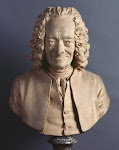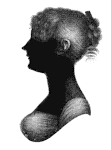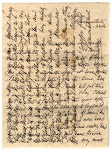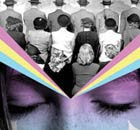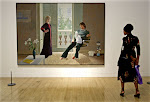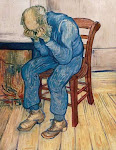I’m still in a biography-reading phase - despite everything that’s being said on this blog about fiction as the truest expression of life and truth. Last week I finished reading Claire Tomalin’s book on Jane Austen - in French – though for some reason I don’t feel the language matters in factual writing. I like Tomalin’s technique at the start when writing pulls you in at once - like a novel - with its description of the icy weather and piled snow around the parsonage at Steventon on the December day of Jane’s birth. Astonishingly a (middle-class) woman who had given birth 1775 wouldn’t leave her bed or her room for a whole month – or even go out of the house for three months! What cossetting when you think of the three days at most that modern women spend in bed before getting back to running a home and other children without much unpaid help..and another surprise, the three month old newborn is then farmed out to a village wetnurse who looks after it day and night, freeing the mother to get on with her social life and the education of other children. What a contrast to our contemporary, guilt-bound delicacy of the mother-child bonding process kept up by constant bodily closeness - and maternal self- abnegation for at least the first three years of life.
Tomalin makes much of this different experience of childhood to explain Jane Austen’s hardiness later in her letters’ references to child mortality. The most famous is her comment on a young neighbour dead a few days after childbirth, “inexplicably according to the doctors – could it be that she caught sight of her husband-” a remark that shocked generations of commentators. The ‘braying of Harpies’ EM Forster is supposed to have said. The fact was, as Tomalin makes clear, that arranged marriage to ugly old widowers in exchange for social status or even livelihood was part of the harsh texture of eighteenth century life and why wouldn’t women be allowed to rail against it and say the truth to each other in private? The abandonment of the useless and the powerless was as normal as death by childbirth. One Austen brother, George, was simple-minded and left to grow up with the village wet-nurse rather than integrated into the family scene with his brothers and sisters by mournful, guilt-ridden parents. “Poor Animal!’ Jane Austen notes in a letter to her sister after a niece has died giving birth to her eleventh offspring. Flagellation and corporal punishment was a fact of life in the navy where the brothers trained as officers and hunting a way of country life for the bourgeoisie . Guilt in general did not seem to have the mental sway and neurosis-hatching power of Freud’s era a century later.
The constraints surrounding a well-born woman are also those of the biographers investigating Jane Austen’s life centuries later. A woman had so little public identity and like the theocratic societies we know of today the Austen sisters were totally dependent on their brothers’ timetables and whims to transport them from one place to another. When Jane was twenty-five and had written – but not published – first versions of three of the six novels, Sense and Sensibility, Northanger Abbey and Pride and Prejudice, her parents decided to give up the family home to her eldest brother and his family and move to temporary rooms in Bath. Tomalin points out that the result of this decision in which Jane had no say at all, was to stop her writing for more than ten years. It wasn’t until her mid-thirties when her wealthiest brother accorded her mother and sister a cottage at Chawton on one of his country estates that she was able to stop a life of incessant transition from country house to country house of various relatives and settle down in her own space and routine to write again, producing Emma and Mansfield Park and Persuasion. Austen’s letters of course – or what remains of those which her sister didn’t destroy, are all that a biographer has to base her work on, along with a few mostly conformist diaries and memoirs which give us a sense of the social round of balls, weddings, funerals. Cassandra, Jane’s sister also left us that big, dark-eyed enigmatic facial portrait that everyone knows, featuring a young, pinched –lipped woman with brown curls escaping from under a very eighteenth century bonnet.
The biography is very well-researched on family relationships and social connections so we get a rich idea of life around a bourgeois parsonage at the end of the eighteenth century. It feels a lot less gloom ridden than the Bronté’s life later in Yorkshire. There’s a lot of noise and horseplay for one because Jane Austen was the seventh child after five boys and a girl. The family home was also a country boarding school for boys. So contrary to the old maidish look of the famous portrait she grew up steeped in boys’ lives and activities. The young men around her were not academics but pragmatic hunters, naval officers, military careerists. Later in life she knew exactly what do when it came to looking after nephews who had lost their mother in childbirth or were running wild between governesses. Unlike other childless writers, eg Woolf, this was not a woman deprived of that human dimension of life with children but a woman with major hands-on experience of children’s needs, tantrums, dreams and games . All of which goes a long way to explain, I think, that rich understanding of human nature that we get in her writing about what is usually agreed to be a ‘very enclosed’ world. Jane Austen was the first to set up this idea in her own reference to working ‘with the finest of brushes’ on ‘two inches of ivory,’ but there is no doubt as to the broad, solid sanity of her vision. The novels are the production of a strong character enmeshed in social contact. The famous ‘inches of ivory’ quotation interestingly was to a nephew who had taken up novel writing. As soon as she began to have some success the nieces and nephews closest to her took to their pens and got her to read and critique their work. They must have admired her and turned thirstily to her for inspiration as among the cohorts of dress-making, birth-giving, tea-partying women around them. An point of note on the setting of the novels is that the Abbeys and Manors of Austen’s writing with their well-endowed heiresses have very little to do with the noisy parsonage where she grew up knowing she was not much of a financial catch for any local squire. Her subject range may have been ‘narrow’ in reference – but like today’s Hollywood family sagas the wealth of its setting was also her own enjoyable escapism from the material limits of her own life.
Why would I like my daughters to read this biography? One reason is Jane Austen’s life demonstrates the use and value of resilience in a milieu and time when lack of strength was deadly. Nor just brute strength but finesse of spirit that combats depression in the face of loss and disapppointment in love as is documented in the novels. What the biography gives us outside Austen’s fiction is evidence of a unique binary relationship between two sisters, the backbone of Jane Austen’s life and unwritten in the novels although from Sense and Sensibility onwards there are pairs and groups of sisters. Tomalin gives us from Austen’s letters, the strange domestic detail of the two sisters sleeping in the same room at night in the cottage at Chawton because Jane likes reading out loud at night to her sister as they both get undressed for bed. As a biographer Tomalin feels she has to point out to the modern reader that she doesn’t think this relationship is in any way sexual. Here is another reason I’d like my daughters to read this biography – to consider subtleties unhighlighted today with what we imagine to be our western/modern monopoly on freedom and pleasure. Or in other words the mystery of love in all its forms.
It’s Cassandra, Jane’s sister of course, whom all the biographers blame for destroying so much evidence that we end up ‘taking leave (of Jane) probably much as she would have liked, as an acquaintance rather than a close friend.’ Tomalin describes the relationship betwen the two sisters in moving detail at Jane Austen’s death. She has been ill from some undefined long illness for nearly two years, some sort of intestinal cancer for which the doctors have no prescription in the end but laudanam. Cassandra sits out the last days, motionlessly for six hours on the bed holding Jane’s head between her hands on a pillow placed on her knees after convulsions nearly throw her sister out of the bed,
‘She was the sun of my life,’ Cassandra writes more movingly to a niece after her sister’s death, ‘she who brightened and embellished all my joys and soothed my sorrows. I never hid the least thought from her and it’s as if I’ve lost a part of myself.’
Cassandra lives to be remembered by her great-nieces as an old woman wrapped in black silk with a big nose and a gentle smile. Her own end comes suddenly one day of a brainstorm when visiting a brother and naval Captain to say to goodbye to him and his family as they put on board ship for the Antilles. In the middle of the chaos of packing cases and departing relatives she collapses and no knows what to do with her. Certainly the ship cannot be put on hold or the Captain’s travel plans delayed. Everyone goes on their way and she is left in another brother’s house to finish dying. Some individuals, - a maiden aunt counted less than others of course but in general we get the feeling that individual counted little compared to today. What mattered was the fabric of society as a whole which each person represented to a greater or lesser degree.
However. Let’s end on a strangely alternative note - the last words of a French ‘witch’ Eleonore Galigai de Concini to her judges when condemned to die at the stake. She is quoted by Voltaire and by Austen in her last letter to a governess who had become a lifelong friend,
“My spell has been the power that stong souls must have over weak spirits.”
How on earth does Jane Austen end up quoting a 17th century sorceress? Tomalin talks a lot in the biography about the influence of a glamorous cousin Eliza who married into a French family, and lived a life of greater social and material freedom than any that the Austen sisters could ever have imagined. Unlike the ‘eventless’ life of the Austens, this Eliza is a biographer’s dream, frequenting French aristocracy, escaping the French revolution, choosing men for love not social survival. She would surely have read Voltaire and discussed his ideas with Jane who writes in this last letter, “Galigaî de Concinci forever!”
The six great novels of social comedy which survive today are but tips of the ice-berg. The gift of the biographer is to let us see some infinitely suggestive glimpse further below the surface.
Friday, March 27
Thursday, March 12
we are essentially fiction-makers living in the (tangled) web of our own various story-lines...
..this is in no way a value-loaded statement but a (very simplistic) paraphrasing of Nancy Huston's work 'L'Espèce Fabulatrice.' One blog-reader returns to this book to unwind what Huston means when she talks about how we make our own meaning out of reality..
(for the English version just scroll down)
Le fait est que nous avons tendance à « fabuler » dans la plupart des circonstances : spontanément ou par un long détour, nous mettons au point de petits arrangements avec la réalité.
Il faudrait s’entendre sur ce que recouvre cette action de « fabuler ». Fabuler, c’est bien-sûr, raconter une histoire ; c’est plus largement en passer par le discours – quelle que soit la forme qu’il prenne – pour interpréter, appréhender, signifier, exprimer, comprendre. L’écueil majeur ici est que dans un sens aussi large fabuler soit affecté d’une ombre, d’une signification négative. Si l’on fabulait sans cesse, on ne serait jamais dans la réalité.
Précisément. Telle est la réalité humaine. Le « réel-réel », la réalité brute compte en vérité pour bien peu. En général, prétexte à autre chose ou matière à interprétation. Alors, nous fabulons. Mais ce n’est pas pour autant de l’air, ce n’est pas du rien : c’est au contraire l’une des manifestations de l’essence même de l’humanité.
Nancy Huston indique trois registres dans lesquels son observation est corroborée :
- A l’échelle de l’espèce, la fiction est un stratagème ou une ruse archaïque visant sa survie et sa perpétuation.
- A l’échelle de l’individu, la fiction est une tendance innée, un mécanisme du cerveau, tout autant qu’une structure de la représentation ou de la conscience.
- A l’échelle sociale, la fiction est un dénominateur commun à tous les groupes humains.
C’est bien toute la réalité humaine que la romancière drape dans l’idée de fiction. Une dernière retouche lui permet de rappeler la contingence radicale du monde : sa justification sur un plan métaphysique ou plus simplement sa signification , ne préexiste pas à l’action humaine : « L’Univers comme tel n’a pas de Sens. Il est silence. Personne n’a mis du Sens dans le monde, personne d’autre que nous. » ( L’espèce fabulatrice p.15). Plus loin : « Le réel est sans nom. » ( idem p.18).
Quel bénéfice y a-t-il à baptiser fable ou fiction toute la réalité humaine, ou la réalité telle que nous l’appréhendons ? A quoi bon mettre au jour le coefficient d’irréalité que porte le langage humain dès lors qu’il s’accomplit en récit ou en histoire ?
Quelques éléments pour nourrir le questionnement :
« […] nous avons besoin que [du] sens se déploie – et ce qui le fait se déployer, ce n’est pas le langage mais le récit. » ( p.16 ).
« Parler ce n’est pas seulement nommer, rendre compte du réel ; c’est aussi toujours, le façonner, l’interpréter et l’inventer. » ( p.18).
in English:
"The fact is that in most cases we tend to ‘make up stories’, either spontaneously or taking a long detour as we do it, we organise our own interpretations of reality
It’s important to be clear on what we mean by this ‘story-telling’. Of course we mean ‘telling a story’, in a wide sense it means working out a personal argument or presentation of sorts – to interpret, make sense of, signify or express. The main trap here is that story-telling is always affected by a shadow, or negative meaning. If we tell stories all the time then we lose contact with reality.
Which brings us to the most important point; - such is the nature of human ‘reality’. ‘True-reality’ or the ‘raw-truth’ in fact counts for very little and in general is but a pretext or material for yet more ‘fabulation.’ And so we go on making up our stories. However having said this, our tendency to ‘fabulation’ around reality is not mere air or nothingness. On the contrary, it is one of the essentials outward signs of human nature itself.
Nancy Huston points out three levels at which she observes this activity :
- for the human species, fiction is a strategy or archaic ruse aimed at self-perpetuation and survival.
- where the individual is concerned fiction is an innate tendency a brain mechanism as much as a structure to do with imaging or consciousness.
- on the social level, fiction is a common denominater in all human groups
The novelist includes the whole of human reality in her concept of fiction. A final adjustment enables her to recall the radically contingent nature of the world: its justification on a metaphysical level or more simply its meaning does not pre-exist human action itself,
“The universe as such has no Meaning. It is silence. Nobody ever put Meaning into the world, noone that is except us” (p15) Further on “reality is nameless.” (p18)
What use is there in baptising ‘fable’ or ‘fiction’ all of human reality, or even reality such as we understand it? What is the point in updating ‘the unreality index’ inherent in human language as it accomplishes itself in story or recital?
Finally, a few more quotations to take us further on the subject:
“(…)our only need it that meaning opens out and applies itself – and what makes it open out thus is not language itself but story-telling” (p16)
“Talking is not only naming, or recounting reality, it’s also the manipulation, interpretation and invention of this very reality.”
(for the English version just scroll down)
Le fait est que nous avons tendance à « fabuler » dans la plupart des circonstances : spontanément ou par un long détour, nous mettons au point de petits arrangements avec la réalité.
Il faudrait s’entendre sur ce que recouvre cette action de « fabuler ». Fabuler, c’est bien-sûr, raconter une histoire ; c’est plus largement en passer par le discours – quelle que soit la forme qu’il prenne – pour interpréter, appréhender, signifier, exprimer, comprendre. L’écueil majeur ici est que dans un sens aussi large fabuler soit affecté d’une ombre, d’une signification négative. Si l’on fabulait sans cesse, on ne serait jamais dans la réalité.
Précisément. Telle est la réalité humaine. Le « réel-réel », la réalité brute compte en vérité pour bien peu. En général, prétexte à autre chose ou matière à interprétation. Alors, nous fabulons. Mais ce n’est pas pour autant de l’air, ce n’est pas du rien : c’est au contraire l’une des manifestations de l’essence même de l’humanité.
Nancy Huston indique trois registres dans lesquels son observation est corroborée :
- A l’échelle de l’espèce, la fiction est un stratagème ou une ruse archaïque visant sa survie et sa perpétuation.
- A l’échelle de l’individu, la fiction est une tendance innée, un mécanisme du cerveau, tout autant qu’une structure de la représentation ou de la conscience.
- A l’échelle sociale, la fiction est un dénominateur commun à tous les groupes humains.
C’est bien toute la réalité humaine que la romancière drape dans l’idée de fiction. Une dernière retouche lui permet de rappeler la contingence radicale du monde : sa justification sur un plan métaphysique ou plus simplement sa signification , ne préexiste pas à l’action humaine : « L’Univers comme tel n’a pas de Sens. Il est silence. Personne n’a mis du Sens dans le monde, personne d’autre que nous. » ( L’espèce fabulatrice p.15). Plus loin : « Le réel est sans nom. » ( idem p.18).
Quel bénéfice y a-t-il à baptiser fable ou fiction toute la réalité humaine, ou la réalité telle que nous l’appréhendons ? A quoi bon mettre au jour le coefficient d’irréalité que porte le langage humain dès lors qu’il s’accomplit en récit ou en histoire ?
Quelques éléments pour nourrir le questionnement :
« […] nous avons besoin que [du] sens se déploie – et ce qui le fait se déployer, ce n’est pas le langage mais le récit. » ( p.16 ).
« Parler ce n’est pas seulement nommer, rendre compte du réel ; c’est aussi toujours, le façonner, l’interpréter et l’inventer. » ( p.18).
in English:
"The fact is that in most cases we tend to ‘make up stories’, either spontaneously or taking a long detour as we do it, we organise our own interpretations of reality
It’s important to be clear on what we mean by this ‘story-telling’. Of course we mean ‘telling a story’, in a wide sense it means working out a personal argument or presentation of sorts – to interpret, make sense of, signify or express. The main trap here is that story-telling is always affected by a shadow, or negative meaning. If we tell stories all the time then we lose contact with reality.
Which brings us to the most important point; - such is the nature of human ‘reality’. ‘True-reality’ or the ‘raw-truth’ in fact counts for very little and in general is but a pretext or material for yet more ‘fabulation.’ And so we go on making up our stories. However having said this, our tendency to ‘fabulation’ around reality is not mere air or nothingness. On the contrary, it is one of the essentials outward signs of human nature itself.
Nancy Huston points out three levels at which she observes this activity :
- for the human species, fiction is a strategy or archaic ruse aimed at self-perpetuation and survival.
- where the individual is concerned fiction is an innate tendency a brain mechanism as much as a structure to do with imaging or consciousness.
- on the social level, fiction is a common denominater in all human groups
The novelist includes the whole of human reality in her concept of fiction. A final adjustment enables her to recall the radically contingent nature of the world: its justification on a metaphysical level or more simply its meaning does not pre-exist human action itself,
“The universe as such has no Meaning. It is silence. Nobody ever put Meaning into the world, noone that is except us” (p15) Further on “reality is nameless.” (p18)
What use is there in baptising ‘fable’ or ‘fiction’ all of human reality, or even reality such as we understand it? What is the point in updating ‘the unreality index’ inherent in human language as it accomplishes itself in story or recital?
Finally, a few more quotations to take us further on the subject:
“(…)our only need it that meaning opens out and applies itself – and what makes it open out thus is not language itself but story-telling” (p16)
“Talking is not only naming, or recounting reality, it’s also the manipulation, interpretation and invention of this very reality.”
Monday, March 2
diaries, sex and narcissistic indulgence...
Journal writing is always highly self-obsessed, Henry Miller says to his lover and diarist Anais Nin. “you are a narcissist. That is the raison dêtre of the journal. Journal writing is a disease. ...I don’t know of any other woman writing so frankly.” Her answer was that narcissists are supposed to love themselves whereas she ..she doesn’t finish the sentence. The four letter L-word is more taboo for her than any other because of the lies she suspects around it. In fact her diary writing is above all obsessed with worrying away at the truth of the self in sexual relationships. Including a double-edged confessional compulsion which means making her lovers read her diary. And then writing in it about their reactions. (Now there’s a neat idea for a blog.)
From time to time I am glad to leave fiction for reading biography or diary writing. It’s a taste that I personally have acquired with age. I don’t remember reading biography with the same interest in my twenties. The accumulation of experience makes you keener not on gossip but in how people describe what happens to them. How they process life.
Next week for international womens’day on March 8th the local mediatheque theatre here in Antibes will host readings in French from the Diaries of Anais Nin. I’d read her late diaries written in her seventies when she was dying of cancer but not the most famous one which provided the material for the film based on her affair with Henry Miller which I read this week. “From her unexpurgated diary” nudges the blurb on the front cover. Ok. ‘Henry and June’ is on one level about a lot of sex, about 'talk melt(ed) into caresses, into deft, acute core-reaching fucking'. In ‘Henry and June’ Nin who is married to a banker and living in a green leafy villa in a nice suburb of Paris meets Miller at her editors where she is working on a book on D.H.Lawrence. They have ‘Lawrentian’ sex which takes place for Nin at least in a sensualist credo of freedom and truth-to-the-self which includes pushing him and herself to betrayal, noting very carefully her own ‘lies’ – the times when she says what she doesn’t feel, pretends pleasure, or enjoys herself with someone she doesn’t love passionately. Her navel-gazing is always lightened by her honesty. She doesn’t run away from her own despair when Miller compares her ‘light’ and ‘freshness’ to his being ‘satiated’ with ‘experience and pain.’ “the word ‘satiation’ terrified me. It seemed like the first drop of poison poured into me” The diary is above all Nin’s attempt to mirror what is happening to her. The writing is, not as Miller tells her, sealed off in its own narcissism. Even if she’s always noting her effect on others and their compliments, detailing her own clothes and perfume (‘mitsouko’ which Miller tells her is too light and flowery) with the soft-sell tone of a fashion columnist, her jewels sandals, big rings, painted fingernails. Miller tells her (and she notes), she’s ‘living some kind of a lie which is not a lie exactly but a fairy tale.’
She observes the rise and fall of each feeling and its contradiction; elation and depression, violent energy and depletion, lust and tiredness. Her own childlike beauty and her nose-job in a private clinic. Her exotic attraction to June, Henry’s wife, which goes nowhere. Repugnance, irritation, jealousy too because like a lot of free-thinking, freedom-intent women of the time Nin was intent on living her sexual relationships outside the confines of monogamy and childbirth. In fact she gave up all her energy to this ‘project’ - and the practice and the telling of it in her diaries – which is why Alice Walker remarks on the book jacket that this writing is ‘profoundly liberating’ and taboo-breaking.
In the end Nin’s diaries are more intriguing for the names she drops than for her quest for sexual truth and blossoming. Sex loomed so large for her because she was living in another age. Another more tightly moral or hypocritical culture where erotic gestures were iconoclastic in themselves because banished from the surface of bourgeois life. Obscenity is nolonger such a big deal as in the era when brothels were legal. When Nin goes to look at the women, and make them act for her like a male client with power to buy, her aestheticism has a fascist slant out of touch with everyday reality. In another brothel to which she takes her husband she complains of the ugliness of the women’like a herd.’ Her freedom is a sort of aesthetic aristocrat’s spurning ordinary constraints like her complaints about Miller’s frayed cuffs and second-hand suits. She loves comfort - insists one of the differences between herself and Miller is that she would come out of the depths of depression for the finesse of a 'lacquered tea-tray' or 'silk stockings.'
Still, I would be glad for my daughters to read Nin’s diaries – when they ‘come of age’ to understand. Nin is close to the life force behind a frank search for happiness. The diaries read like she had a better time in her arrangement with ‘Henry and June’ than her contemporary Simone de Beauvoir (who also lived an ‘open’ ‘authentic’ relationship with Sartre, tried to fall in love with his women too as Nin first fell into a sort of infatuation with Henry’s June.) De Beauvoir and Sartre were each the other’s ‘diary’ with their agreement to recount each other the details of their affairs with others. I think Nin’s honesty to herself about sex is one of the reasons for the sense of fulfilment her diaries give off. Plus unlike Sartre and de Beavoir erotic sensuality not philosophy was the basis of their relationship with life and writing as well as each other. Literature-making and talk of Proust with Miller in Place Clichy must have been closer to blood and guts reality, to the sweet and sour taste of life than existential revolution.
Anaîs Nin and Simone de Beavoir – the two names side by side is like comparing a cocktail with a grainy expresso café dished out over the zinc counter of a brasserie in the Latin quarter. I wonder if they ever met up, accidentally or otherwise. Each woman certainly knew in her own way what it was to make a life around a man’s contradictions, as Nin writes of Henry Miller,
‘at moments he can say the most delicate or profound things. But his softness is dangerous, because when he writes he does not write with love, he writes to caricature, to attack, to ridicule, to destroy; to rebel. He is always against something. Anger incites him. I am always for something. Anger poisons me.’
From time to time I am glad to leave fiction for reading biography or diary writing. It’s a taste that I personally have acquired with age. I don’t remember reading biography with the same interest in my twenties. The accumulation of experience makes you keener not on gossip but in how people describe what happens to them. How they process life.
Next week for international womens’day on March 8th the local mediatheque theatre here in Antibes will host readings in French from the Diaries of Anais Nin. I’d read her late diaries written in her seventies when she was dying of cancer but not the most famous one which provided the material for the film based on her affair with Henry Miller which I read this week. “From her unexpurgated diary” nudges the blurb on the front cover. Ok. ‘Henry and June’ is on one level about a lot of sex, about 'talk melt(ed) into caresses, into deft, acute core-reaching fucking'. In ‘Henry and June’ Nin who is married to a banker and living in a green leafy villa in a nice suburb of Paris meets Miller at her editors where she is working on a book on D.H.Lawrence. They have ‘Lawrentian’ sex which takes place for Nin at least in a sensualist credo of freedom and truth-to-the-self which includes pushing him and herself to betrayal, noting very carefully her own ‘lies’ – the times when she says what she doesn’t feel, pretends pleasure, or enjoys herself with someone she doesn’t love passionately. Her navel-gazing is always lightened by her honesty. She doesn’t run away from her own despair when Miller compares her ‘light’ and ‘freshness’ to his being ‘satiated’ with ‘experience and pain.’ “the word ‘satiation’ terrified me. It seemed like the first drop of poison poured into me” The diary is above all Nin’s attempt to mirror what is happening to her. The writing is, not as Miller tells her, sealed off in its own narcissism. Even if she’s always noting her effect on others and their compliments, detailing her own clothes and perfume (‘mitsouko’ which Miller tells her is too light and flowery) with the soft-sell tone of a fashion columnist, her jewels sandals, big rings, painted fingernails. Miller tells her (and she notes), she’s ‘living some kind of a lie which is not a lie exactly but a fairy tale.’
She observes the rise and fall of each feeling and its contradiction; elation and depression, violent energy and depletion, lust and tiredness. Her own childlike beauty and her nose-job in a private clinic. Her exotic attraction to June, Henry’s wife, which goes nowhere. Repugnance, irritation, jealousy too because like a lot of free-thinking, freedom-intent women of the time Nin was intent on living her sexual relationships outside the confines of monogamy and childbirth. In fact she gave up all her energy to this ‘project’ - and the practice and the telling of it in her diaries – which is why Alice Walker remarks on the book jacket that this writing is ‘profoundly liberating’ and taboo-breaking.
In the end Nin’s diaries are more intriguing for the names she drops than for her quest for sexual truth and blossoming. Sex loomed so large for her because she was living in another age. Another more tightly moral or hypocritical culture where erotic gestures were iconoclastic in themselves because banished from the surface of bourgeois life. Obscenity is nolonger such a big deal as in the era when brothels were legal. When Nin goes to look at the women, and make them act for her like a male client with power to buy, her aestheticism has a fascist slant out of touch with everyday reality. In another brothel to which she takes her husband she complains of the ugliness of the women’like a herd.’ Her freedom is a sort of aesthetic aristocrat’s spurning ordinary constraints like her complaints about Miller’s frayed cuffs and second-hand suits. She loves comfort - insists one of the differences between herself and Miller is that she would come out of the depths of depression for the finesse of a 'lacquered tea-tray' or 'silk stockings.'
Still, I would be glad for my daughters to read Nin’s diaries – when they ‘come of age’ to understand. Nin is close to the life force behind a frank search for happiness. The diaries read like she had a better time in her arrangement with ‘Henry and June’ than her contemporary Simone de Beauvoir (who also lived an ‘open’ ‘authentic’ relationship with Sartre, tried to fall in love with his women too as Nin first fell into a sort of infatuation with Henry’s June.) De Beauvoir and Sartre were each the other’s ‘diary’ with their agreement to recount each other the details of their affairs with others. I think Nin’s honesty to herself about sex is one of the reasons for the sense of fulfilment her diaries give off. Plus unlike Sartre and de Beavoir erotic sensuality not philosophy was the basis of their relationship with life and writing as well as each other. Literature-making and talk of Proust with Miller in Place Clichy must have been closer to blood and guts reality, to the sweet and sour taste of life than existential revolution.
Anaîs Nin and Simone de Beavoir – the two names side by side is like comparing a cocktail with a grainy expresso café dished out over the zinc counter of a brasserie in the Latin quarter. I wonder if they ever met up, accidentally or otherwise. Each woman certainly knew in her own way what it was to make a life around a man’s contradictions, as Nin writes of Henry Miller,
‘at moments he can say the most delicate or profound things. But his softness is dangerous, because when he writes he does not write with love, he writes to caricature, to attack, to ridicule, to destroy; to rebel. He is always against something. Anger incites him. I am always for something. Anger poisons me.’
Subscribe to:
Comments (Atom)

